One of the most important advantages of the corner kitchen set is the rational use of space. As a result, you will be pleased not only with the appearance and design, but also with the functionality and spaciousness of the kitchen unit. In addition, corner kitchens are suitable for large, medium and even small rooms.
Advantages of corner kitchen units
It is not surprising that corner kitchens are considered the most convenient and popular kitchen set models. Unlike a straight kitchen, corner sets use all areas of the room that are not used by other models of kitchen modules. The special value of this furniture is aesthetic. Corner kitchens will help to visually hide the pipes. If a straight wall is not suitable for every room, then among the corner kitchen modules there will definitely be a suitable option.
The main advantages of a corner kitchen:
- ergonomics: in a corner set you can combine the kitchen working triangle (refrigerator-sink-stove) with maximum comfort;
- ideal for a small kitchen;
- The L-shaped set will help to divide the room into two zones: dining and working;
- corner cabinets are very spacious: they can accommodate carousel shelves, large spacious drawers of non-standard shape;
- corner kitchens are easily combined with a bar counter and other elements;
- you can easily select and buy inexpensive models of corner kitchen units at reasonable prices;
- Economy class corner kitchen units look much more presentable than similar models with a straight layout.
Corner sink: advantages
The sink can be installed in a corner and thus rationally use the available space. Moreover, this is good way save money, because the cost of installing pipes in the kitchen is reduced, thereby reducing the distance from the source to the point where the pipes enter the room. But this option is available if the width of the wall from the door (window) opening to the corner is from 1 meter. This will ensure proper access to the sink. They save a lot of space and are practical to use, which is what made them popular.
Corner cabinet
If you don’t want to place the sink in the corner, you can install a corner cabinet there. It has good capacity and will be able to make the most of the available space. Ordinary drawers lose significantly when compared with corner cabinets. These storage units will accommodate a bar, large pots, long kitchen utensils, water supply systems, meters, filter.
Corner penalty
This kitchen module is considered one of the most unusual. His bottom part matches the corner cabinet. What distinguishes it is the continuity of the floor and wall cabinets. Therefore, in this option there is no work wall and tabletop, because their place is taken by a corner pencil case. This kitchen module is very convenient to use in rooms with complex design or with original corners, or if necessary, hide communications or any imperfections in the corner of the wall from prying eyes (for example, uneven surface angle). Another advantage of the corner pencil case is its spaciousness.
To install a corner cabinet in the kitchen, it is better not to buy a ready-made module, but to order its production, taking into account the actual dimensions of the room.
Cabinets for built-in appliances
These kitchen modules are a special niche that houses kitchen appliances (oven, dishwasher, refrigerator, MKV oven, etc.). But it is better to choose kitchen modules for built-in devices together with appliances. Otherwise, you will have to select a stove, stove, etc. technical elements, based on size kitchen furniture. And this may drag on indefinitely.
A huge advantage of modules for built-in equipment is the ability to freely choose any necessary equipment, based on your personal needs and aesthetic preferences. If your budget has no financial restrictions, then this option for a corner set will be the most successful. The kitchen will not only be multifunctional, but also stylish, comfortable, and cozy.
Models of corner kitchen units with built-in appliances (photo)




![]()

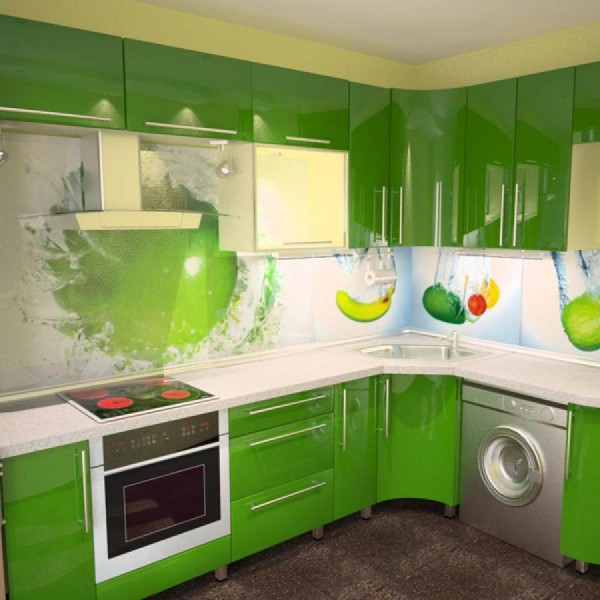
Design and models
The features of corner kitchen sets allow you to show your imagination and create unique image your kitchen. Like other kitchen furniture models, corner kitchen furniture requires special lighting. So, it is necessary to install spotlights above the working surface. And in the corner it is better to concentrate more intense lighting, especially if there is a sink or hob. If desired, you can install lamps on the bottom of the doors of wall cabinets and complement them with lighting on the bottom of the pendant module. Lighting occupies a special place in the design of a corner kitchen. Here you need to act on the principle: the more light in the work area, the better.
If the room is small and needs visual correction and expansion of space, it is better to choose open hanging shelves and cabinets with glass doors.
It should be noted that you can purchase a ready-made corner kitchen set, or you can make it to order, taking into account the size of your kitchen and individual wishes. In the second case, it is better to entrust the creation of a sketch or project of a corner kitchen set to an experienced designer who will take into account all the nuances and make the set practical and beautiful.
Color range
The color of the kitchen set can be any: it all depends on your personal preferences.
For connoisseurs of the classics, a monochromatic kitchen set with discreet and pastel shades: beige, cream, light blue, brown, white.
Fans of the Brave color solutions can choose corner kitchen modules with a combination of two colors. To do this, you can choose, for example: contrasting options (white-black, orange-white, etc.) or furniture of the same color with a play of tones (cream-chocolate). It is important to remember that it is better to choose a corner element of a light shade, otherwise the room will receive unnecessary “heaviness”, and the wall will visually appear smaller.
Small corner kitchen set lilac color(photo)

Bar counter
Corner kitchen units can be equipped with a bar counter. However, it is not necessary that the room be large. For example, in a small kitchen, a bar counter can be easily integrated into the work surface of the table. This way you will save space and provide your kitchen with a desired element.
The stand can be located on the lower cabinet or become a mini-table: then you will not need additional lower modules. In this case, you can get by with a regular tabletop or glass surface, which will visually expand the space.
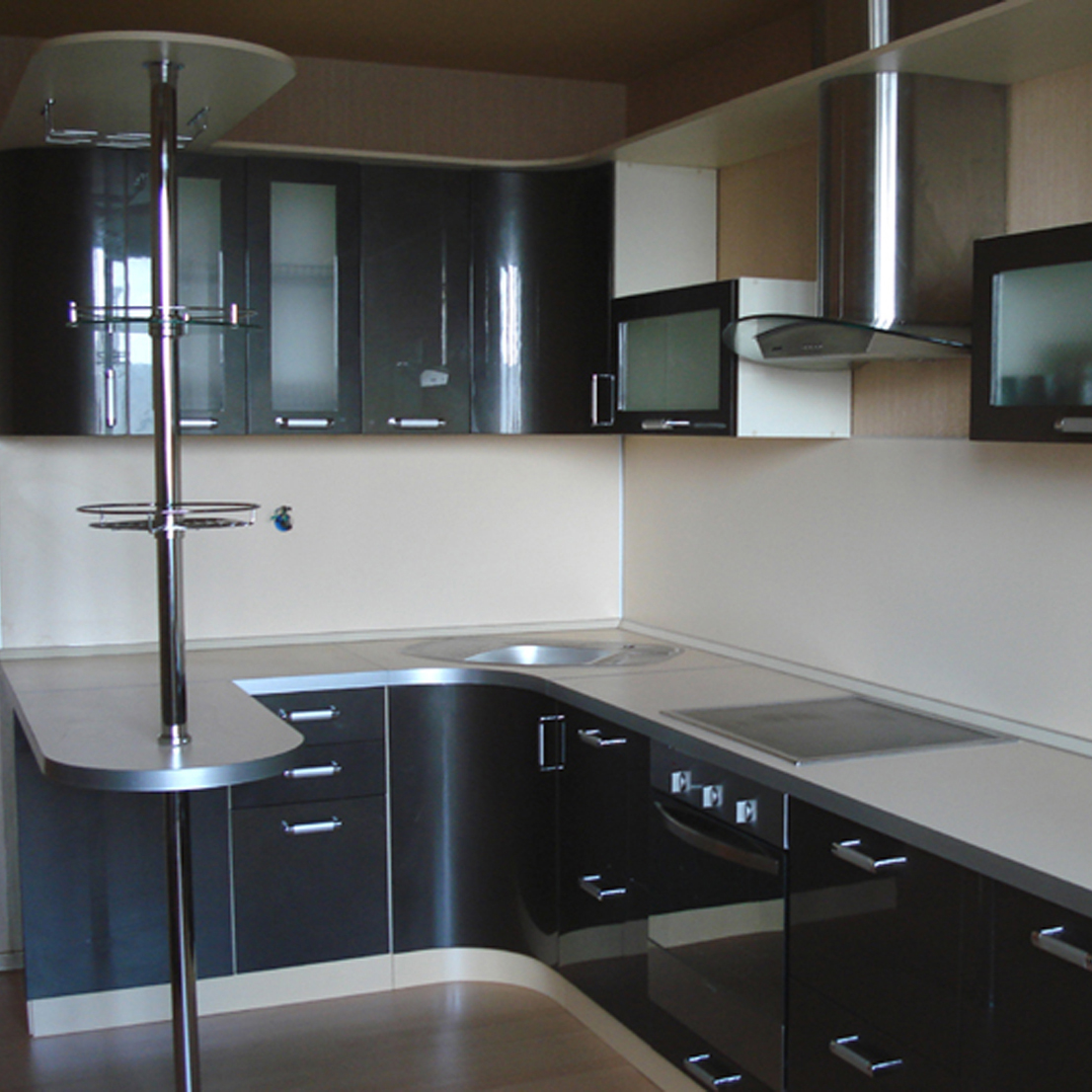
If the room is very small, the bar counter should be installed in the gap between the upper and lower modules. In this case, the lower module is a continuation of the lower part of the headset, and the upper one is limited by small open shelves.
IN big room(kitchen-living room, for example) a bar counter can become a conditional separator between the work space and the relaxation area.
The height of the bar counter may vary. Its standard sizes are from 110 to 125 cm.
Bent facades
Corner kitchen sets with curved facades are suitable for rooms with any layout. They can be installed in a room of any size. Kitchen corner set with curved facades will help to visually adjust the space and make maximum use of the corners of the room. A huge advantage of such kitchens is the opportunity to realize any of your design fantasies and give the facades the desired shape. As a result, you can create a unique kitchen based on your dreams and wishes. True, to make an exclusive kitchen, you will need more finances than for a set of standard design.
Optimal sizes
The size of a corner kitchen set is determined individually and is based on three criteria: the area of the room, its layout and your financial capabilities.
The mandatory minimum for a kitchen is a set of at least 1 meter in length, consisting of two floor cabinets and 2-3 hanging modules. The standard size of a kitchen set is from 2.5 to 4 meters. This set includes 4-5 floor cabinets, 5-6 wall-mounted modules, and a sink cabinet.
In total, the area occupied by the corner set should not exceed 40% of the entire room. Otherwise, such a kitchen will be uncomfortable and uncomfortable. The optimal area of the headset is, as a rule, 25-35% of the total kitchen area.
Photos of corner kitchen units
Kitchen furniture is too important a choice. Therefore, there is no need to rush and buy the first model you like. It is better to carefully study the market assortment, view photos of corner kitchen sets with different colors and design solutions. If you know how to use computer programs, you can independently create several options with virtual photographs of your future kitchen or seek help from a designer.
Whatever corner kitchen you choose and whatever space layout interests you, rest assured: a corner kitchen set will make your kitchen a multifunctional and comfortable place to relax, a pleasant area for preparing delicious food for you and your loved ones.
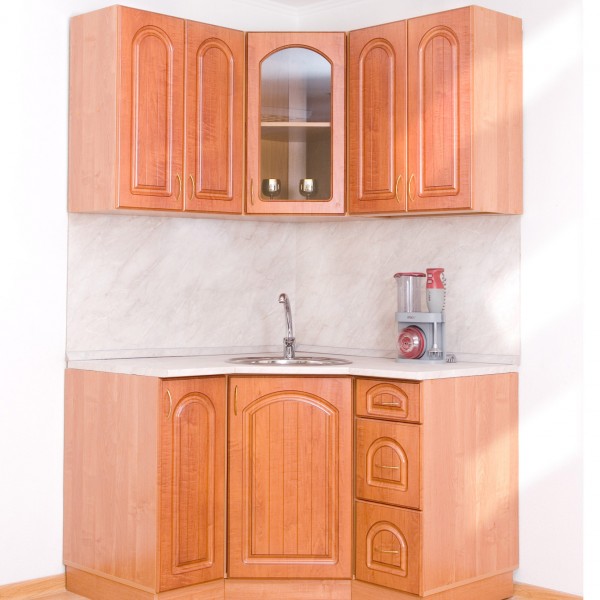
 Inexpensive corner kitchen set
Inexpensive corner kitchen set 
 Corner kitchen set (classic)
Corner kitchen set (classic)
- Distinctive features of corner furniture
- Preparatory work
- Required tools and materials
- Stages of making a corner kitchen cabinet
If you are the owner of a rather modest-sized kitchen, it is in your interests to rationally use literally every cm of usable space. It is very convenient in such a situation to use the angular kitchen cabinet, which will allow you to store kitchen utensils as profitably as possible.
A small kitchen requires careful use of every centimeter, including the corner of the kitchen unit, which is ideal for a built-in sink.
If your kitchen has a non-standard layout and it’s difficult for you to find kitchen cabinet required size– don’t despair, because you can make a corner cabinet for your kitchen with your own hands!
Distinctive features of corner furniture
The standards that are used in the process of making kitchen furniture with your own hands are directly dependent on the parameters that affect the size of the assembled cabinet.
The lower corner cabinet has the following main parameters:

In addition to certain dimensions, you need to decide what kind of configuration your corner kitchen cabinet will have. The following types of configurations are distinguished:
- cabinets in the shape of the letter “L”;
- modular cabinets;
- trapezoidal cabinets.
L-shaped cabinets are the most popular because they are very convenient. The cabinet doors open according to the trolleybus principle, so the interior contents of the cabinet are clearly visible and convenient to use. It would be advisable to equip such a cabinet with special carousel shelves that can rotate at a maximum angle.
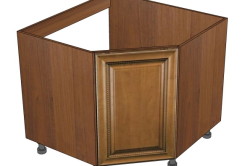
Figure 2: The corner trapezoidal unit creates ample storage space.
Arranging a cabinet of this type will help save a lot of space. In this design you can successfully place a sink for washing dishes. This couldn’t come at a better time, because in those built in the Soviet era apartment buildings water pipes pass right in the corner. For this reason, in order to avoid lengthening communications, it is very convenient to install the sink in the corner (Fig. 1).
The attached corner cabinet consists of 2 modules: a cabinet installed in the corner of the kitchen, and another cabinet with a door placed at a right angle to the cabinet. This design is not entirely convenient, since free access is provided only to the contents of the cabinet with the door.
Cabinets of this configuration can also accommodate a sink. In this case, it is better to hide the plumbing in a remote part, and arrange drawers for dishes in an accessible module, household chemicals etc.
The modular design of a kitchen corner cabinet has a big drawback: the blind part is difficult to access. If there is a need to repair plumbing, it will be a difficult task if it is located in a blind module. If you place the pipes in the accessible half, the blind half will be empty.
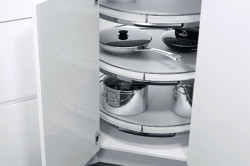
Using a carousel for a corner cabinet makes it easier to reach even the furthest corners.
A compromise is possible - install a corner modular cabinet in the corner opposite the sink and use it to store various kitchen utensils. You can not install doors on it and install a microwave or build a minibar in it.
Corner cabinet, trapezoidal in shape, equipped with one door. On the periphery of the cabinet you can install other elements of kitchen furniture. The trapezoid cabinet looks extraordinary and looks good in large kitchens (Figure 2).
But there are some disadvantages to using a trapezoidal kitchen cabinet:
- A straight door blocks the area near the wall. Therefore, it is best to use such furniture to accommodate a microwave, food processor and other household appliances.
- If you install a carousel in your cabinet and install a sink in it, you may increase the likelihood of plumbing failures. The steel carousel will continuously deform the siphon due to continuous friction.
Now that we’ve figured out the features and shapes, let’s start building a corner kitchen cabinet with our own hands.
Return to contents
Preparatory work
Before construction, any structure must first be designed.
Kitchen cabinet layout includes the following steps:

Figure 3. An example of a corner cabinet layout.
- Definition functional purpose: it will be the basis for the sink, work area or a place to store dishes and other kitchen utensils.
- Make calculations of the overall dimensions of the cabinet and the dimensions of each individual element.
- Decide on the filling of the internal space. These can be ordinary shelves, a carousel or drawers. Define required quantity shelves and spaces between them.
- Think about the style of the design and what color it will be.
- Lastly, decide what material you will need to construct the designed cabinet. We advise you to pay attention to LDSM (laminated chipboard) with a thickness of 1.6-1.8 cm. The advantages of this material are that it is easy to clean, repels water, has an aesthetic appearance and a relatively low cost.
Summarizing the project, draw a diagram finished product(Fig. 3).
Return to contents
Required tools and materials
To design a corner cabinet for your kitchen, you will need the following materials:
- laminated chipboard panels;
- edge for the uncovered ends of the cabinet, it is best to use PVC for the facade 0.2 cm thick;
- furniture screed;
- pendants;
- furniture fittings (door handles, door handles, etc.).
You should have the following tools at hand:
- confirmations measuring 4×0.45 and 5×0.7 cm;
- self-tapping screws;
- dowels;
- sealant;
- a piece of sandpaper;
- drill with sets of drills on a wooden surface;
- hex wrench;
- roulette;
- level.
The kitchen is the place where a woman spends a significant part of her time. And how tired she gets after cooking depends on the convenience of the arrangement of kitchen furniture in the form of cabinets.
Stores offer many kitchen modules; you can choose or order any size. But if the owner of the house decides to select and install them himself, then he needs to know standard sizes and the main dimensions of the kitchen set.
Kitchen furniture can be:
- floor;
- mounted;
- angular.
Floor
This furniture forms the basis of any kitchen. It is in such cabinets that various types of kitchen furniture, utensils, and household appliances are stored. The lower cabinets may contain large appliances such as refrigerators, dishwashers, washing machines, etc.

Mounted
Such furniture is fixed above the bottom one 0.4–0.5 m higher. Suitable for storing small household appliances, some products, and various utensils. They are often used to disguise gas pipes and other elements that are hidden from prying eyes. The height of kitchen cabinets should depend on human height, so that without replacing a chair, you can take everything you need from the top shelf. Although, if such a need arises, it can be installed up to the ceiling.

Corner
The use of such cabinets is carried out in models of kitchen furniture that flow from one wall to another. Advantages of these modules in maximizing the use of the angle using draw-out models and similar elements.

Standards for suitable dimensions of a kitchen set: depth, width, height
Upper cabinets are subject to the following standards:
- Height – from 79 to 90 cm.
- Depth - 0.3 m (if the tabletop is wider, then usually the depth of the top row is equal to half of it).
- Distance from apron area ( work surface) not less than 450 mm (this parameter can be easily adjusted to a comfortable level, based on the height of the owner, maybe 55–60 cm)
- The width of the fronts of the upper cabinets is identical to the lower row.
- The distance to the hood should be 70–75 cm for an electric stove and 75–80 for a gas stove.
- The height of the upper modules from the floor is permissible no more than 210 cm.
You should remember the basic parameters for wall cabinets– about the distance from the bottom to the shelves at the top of 45 cm. This will allow a convenient location all the necessary household appliances on the work surface. You should not worry about hitting your head on furniture, because it is much smaller in depth than the floor part and will not interfere with work.
Wall-mounted kitchen unit modules can be arranged even higher, customizing them to suit any person individually. You should not hang cabinets too low; it will be inconvenient to use the work surface.
Corner cabinets are popular pieces of furniture that allow you to take up space that is not usually used for any purpose. They can be created from different materials, and in a variety of styles, which allows you to choose a great option for any kitchen. The installed corner kitchen cabinet has different types, sizes, drawings, which can be selected at your discretion.
Design Features
The positive parameters of using a corner cabinet include:
- due to its use, the usable area of the room is significantly increased, since the installation is carried out in a place that is not used for any other purposes or installation of other furnishings;
- although visually a kitchen floor cabinet intended for a corner has small in size, in fact, it is distinguished by its excellent spaciousness and versatility, as it is equipped with different shelves, drawers or compartments for storing a variety of products or utensils;
- The sizes of kitchen cabinets can be different, which makes it possible to choose best option for premises;
- can be used for façade decoration various methods, so they can be equipped different decor or even made of glass, which has a positive effect on the appearance of the kitchen;
- if selected corner kitchen, then the kitchen set already includes corner cabinets for installation on the floor or for hanging on the wall, so they fit perfectly with other elements;
- In the kitchen, such a design always looks interesting, harmonious and stylish.
To create interesting appearance The room usually combines a floor-mounted corner piece of furniture with a wall cabinet.
Other features of such furniture include:
- corner design equipped with doors or created without them, and in open models You should only store attractive and beautiful dishes;
- the shape of such a cabinet can be triangular, trapezoidal or L-shaped, and the choice depends on the preferences of the property owners;
- certain models are equipped with drawers in which small items can be stored, therefore combining a compact design with good capacity;
- usually the lower element is used under the sink;
- Often, various large household appliances can be installed in such a cabinet, which allows you to use them effectively in the kitchen;
- can be used to decorate the facade different ways, for example, drawing is used sandblaster or upholstery in leather or fabric;
- the lower elements can be equipped with legs or produced without them, and in the first case the ease of cleaning the room is ensured.
Cabinets equipped with carousel shelves are considered interesting, as they are ideal solution for storing dishes.




Dimensions depending on type
The dimensions of these structures may vary. If they are part of a headset, they are the ideal size for connecting with other elements. If selected separately, they must match other straight cabinets. The dimensions of a corner piece of furniture may differ depending on whether it is floor-mounted or wall-mounted.
Mounted
If selected top cabinet angular type, then its dimensions are equal to:
- usually these elements are not used for installing large-sized household appliances; it is allowed to make them not too durable and spacious;
- the width can vary from 15 to 80 cm, and this parameter depends on the shape of the cabinet, since it can be triangular, trapezoidal, L-shaped or some other;
- the standard depth is 35 cm, but when choosing it, the depth of the lower drawers is taken into account, since these elements must fit perfectly with each other, otherwise the kitchen will not look harmonious;
- It is recommended to attach a corner wall cabinet for the kitchen at a distance of about 50 cm from the lower cabinets, but a deviation of 5 cm in different directions is allowed.
The above dimensions are considered standard and frequently encountered, but it is possible to choose designs with completely different dimensions, since the main factor is that they should be spacious, easy to use and attractive. The corner structure can be so small that it can be placed in a small niche, if there is one in the room. Often attached above hob, therefore it will be used to store different spoons or spatulas used in preparing various dishes. When choosing a facade, it is taken into account that there may be one door or several of these elements. You can choose models that are not equipped with doors.





Floor
If you choose a lower cabinet, then the standard dimensions will be:
- Dimensions are selected depending on the parameters of the selected kitchen unit, and it is recommended to take into account the dimensions, height and other parameters of the stove, which can be gas or electric;
- if the kitchen is small in size, then it is advisable to choose a depth not exceeding 50 cm;
- the standard height is 85 cm, but this parameter can be adjusted in certain cabinets, since for many people this height is considered too significant;
- The width varies from 15 to 80 cm, with 60 cm being considered optimal.
An interesting solution would be to purchase a corner structure with dimensions of 600x600 mm, which will have optimal dimensions, so it will be really convenient to use.
Usually the lower element is installed after the upper one is attached. The lower structure should be symmetrical to the upper one. You can choose an element with or without legs.





Under the sink
Quite often, corner floor products are chosen for the sink. Their sizes can vary significantly, as they depend on the dimensions of the sink itself. It is taken into account how the structure will be fixed, since you can buy a mortise or overhead sink. Due to large quantity With various sinks, there are certain difficulties in choosing the optimal cabinet correctly, so it is advisable to first select the sink, and then the piece of furniture.
For such cabinets, standard dimensions are considered optimal, but if you need to obtain any unusual design, then all parameters are calculated individually. The width can exceed 60 cm, and the depth can even reach 80 cm, although using such a cabinet will be difficult. Usually, for large products, two facades are chosen for the sink, but you can choose a model with one door. An excellent choice for any room would be the Madeleine kitchen, which has interesting view, affordable cost and high quality.




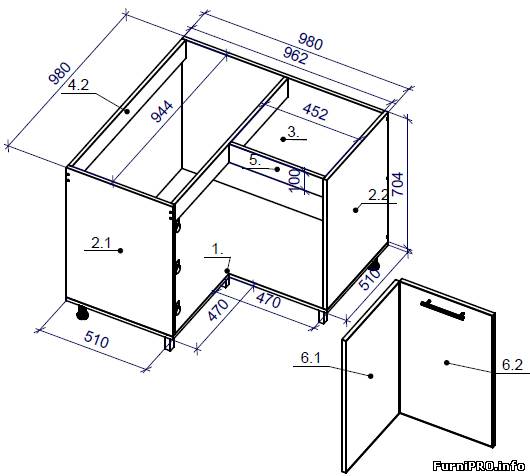
Angular
A standard corner piece of furniture has different parameters. It can be mounted or floor-mounted, and is also created from a variety of materials. The most popular is the corner structure made from natural wood, but its cost will be extremely high. Needs constant protection wooden product from moisture, which is not always optimal for the kitchen.
An excellent choice would be products made from laminated MDF or plastic. When determining the optimal dimensions, the recommendations of professionals are taken into account:
- the width of the base, which varies from 10 to 12 cm, and this indicator is not affected by the selected type of stand, so you can choose either a design with legs or a solid cabinet;
- the height is usually chosen within 70 cm, but if the product is equipped with a sink, then it is advisable to choose a lower design so that the sink achieves a single level with all the other cabinets that are part of the kitchen unit, and the lower element ensures ease of washing dishes;
- the height of the tabletop can be from 2 to 4 cm, and this parameter depends on what material was used for its production, as well as what structure it has;
- the width also varies from 40 to 80 cm, and this parameter is influenced by the shape of the corner cabinet, the filling of the element, since it may have not only shelves, but also drawers, as well as other storage systems;
- the depth varies from 30 to 50 cm, and it is selected depending on the same parameter of other straight cabinets installed nearby.
Thus, the dimensions of corner cabinets can vary significantly. They depend on numerous factors, and initially the ease of use of the structure for its intended purpose should be taken into account, and this especially applies to a cabinet that will be equipped with a sink, since the right choice The comfort of washing dishes depends on the dimensions.
The distance between the lower and upper corner cabinet is standard 60 cm, but this parameter can be easily changed, since it takes into account the height of the regular user of the kitchen.





Measurements and drawing
Corner kitchen cabinets can have different sizes, are presented in numerous forms, and there are also various drawings according to which they can be made. When choosing dimensions, you need to take the correct measurements, and it is also advisable to make a diagram of the kitchen so as not to make a mistake with the choice. In this case, the recommendations taken into account when drawing up the drawing and taking measurements are taken into account:
- The thickness of the shelves is selected depending on what items will be stored on them. It is advisable to show on the diagram whether the corner structure will accommodate household appliances or light spices. Standard shelves are 18 cm thick, but if heavy objects are stored, it is advisable to choose a thickness of 21 cm or more.
- The depth of hanging boxes should not exceed 40 cm. It is taken into account that in the corner there are usually elements for connecting to communication systems, so it is often impossible to place any large objects in corner cabinets, since various pipes or wires are laid here.
- It is not allowed to hang a wall cabinet low if there is a stove underneath it. This is especially important if the structure is made of plastic, since under the influence high temperature the material begins to melt.
- The standard size of a corner cabinet is 60x60 cm, and the width of the facade is 42 cm, and the depth with such dimensions is equal to 30 cm.
Corner cabinets are considered excellent choice for any kitchen. They are presented in many models, so the corner kitchen cabinet and the types of sizes and drawings are different. When choosing, especially much attention is paid to the dimensions so that the products are convenient to use and spacious. It is first recommended to create a special drawing of the kitchen, according to which all elements for installation in this room are selected, as well as a cabinet for the kitchen.

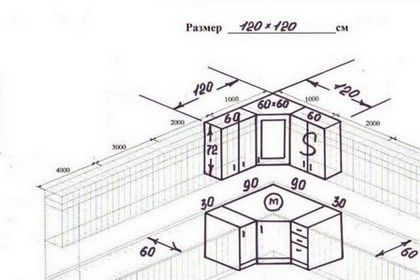


Video
The sink cabinet is an important part of the kitchen unit, which holds the sink, which can be made of stone and weigh over 10 kg. The sink is usually not attached to the wall, since, acting on the principle of a lever, it will inevitably tear out the mounting bolts. Therefore, unlike other prefabricated cabinets, the set must be of reinforced construction. The size of the cabinet is determined by the size of the sink.
What types of kitchen sink cabinets are there?
There are actually few options for the location and formation of a cabinet for a sink; it depends on the configuration and square footage of the kitchen space and on the method of placing pieces of furniture.

There are two types:
- Straight cabinet installed where the sink is located between other cabinets or next to the stove;
- Corner cabinet can be either L-shaped in the form of two connected straight cabinets, or with a door beveled at 45 degrees. This is very practical option, since the sink is often located in the corner for convenience.
In both cases, the design of such a cabinet for a sink with a spacious cavity is reinforced with transverse joists, since the back wall is missing partially or completely due to the need for water supply.
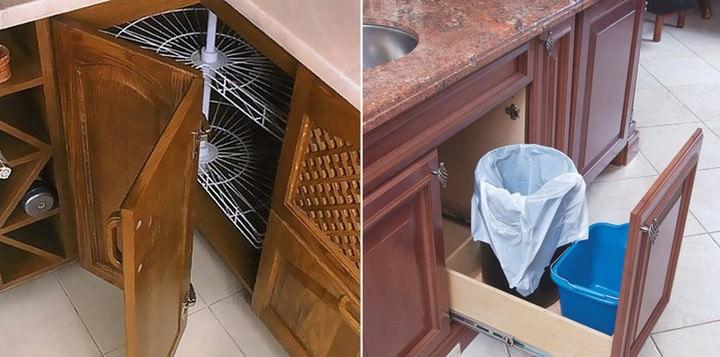
The cabinets have shelves or drawers for storing small utensils. On the other hand, it is necessary to have access to the siphon and sewerage parts in order to immediately correct any leaks that have arisen.
How convenient is a corner cabinet for a kitchen sink?
The corner location of the sink is by no means uncommon for miniature kitchen spaces. If the sink is represented by two separate sinks, between which the tap is located, then the cabinet is L-shaped, and the doors open in such a way that they interfere with simultaneous access to both cabinets.

Most preferred corner option single-door vanity cabinet with a beveled front edge. In such a cabinet you can place drawers or several shelves. In this case, the size of the cabinet space is increased due to the beveled front edge, which does not prevent close contact with the sink.
Furniture design: cabinet for sink (video)
Sink drawer for the kitchen: convenience or practicality
The configuration of the sink cabinet can be without a sash. Instead of the sash (or above it) it is used drawer on roller conveyors of the appropriate size. This box has unusual shape, with a recess in the middle, where the sink drain and siphon pass.

Such a box is appropriate for the bathroom, where you can put all the necessary little things in it, such as shaving accessories, creams, soap supplies, etc. In the kitchen, only small items can be stored in this drawer, since its fastenings do not allow overloading. It's hard to imagine storing dinnerware in it, since the table is usually located at a distance from the sink, and in order to take forks and spoons you will need to move significantly.

The only reason why we can recommend a drawer under the sink is to keep kitchen furniture in the same style, where absolutely all cabinets have drawers. By the way, there may be more than one drawer, but under the top one, with a recess for a siphon, there may be a second, more spacious one, in which you can store supplies of detergents and large bottle with vegetable oil.
Typical dimensions of a kitchen sink cabinet
The height of the cabinet under the sink should be the same as all other items in the set, because they are united and covered by a common countertop, on which food is cut before it is processed.

The size of the cabinet, of course, depends on the size of the sink (or even two sinks located in series). The wide wardrobe can be equipped with two hinged doors door leaves. A narrow sink 30-40 cm is usually placed on single-door cabinets. Wide cabinets 60-80 cm allow you to hang two door leaves.

The height of such cabinets is about 1.5 meters. This allows you to avoid bending over too much when using the sink. Of course, if you make furniture to order, you can take into account the peculiarities of your height, but making floor cabinets too high will not work, since a fairly large space is needed between the first and second tiers of furniture.
Sink cabinet with aluminum tray (video)
Cabinet for built-in kitchen appliances
Built-in appliances, as a rule, are located in cabinets adjacent to the sink, since a significant part of the space under the sink is occupied by a siphon, especially if there are two or three sinks. In addition, the furniture under the sink runs the risk of being flooded if the water supply suddenly breaks down.

If you place built-in appliances directly under the sink, access to it will be partially limited since it is extremely inconvenient to stand at the sink and use it, while simultaneously trying to access the built-in appliances directly under it.

In general, some equipment items can be placed in lockers:
- Compact refrigerator or freezer;
- Small washing machine side loading;
- Dishwasher.
Existing sizes kitchen appliances allow you to do this.
How to integrate equipment into furniture (video)
A cabinet for a sink or for built-in appliances is made in the same style as other cabinets that make up a range of kitchen furniture. It is recommended to make a corner cabinet with a vertical plane beveled at 45 degrees, connecting both corners. Features of the fastening and location of the sink require increased strength from the cabinet and partially missing back wall, through which water is supplied and discharged to the kitchen faucet. If the kitchen space is very small, then some built-in appliances such as a dishwasher and washing machine can be located in the cabinets.
Attention, TODAY only!
